Abbeye Ardenne – German Atrocities and the Bayeaux Tapestry
The Bayeux Tapestry
After three wonderful days based in Bayeux visiting the D-Day sites, Liberation Tour 2015 headed out for the port of Dieppe, but not before we had a chance to see the Bayeux Tapestry and stop at Abbeye d’Ardenne where the Germans murdered twenty or more of my fellow Nova Scotians.

Mark did a great job getting the group to the museum early enough that we didn’t need to stand in line and where able to enjoy the Bayeux Tapestry without being jostled by others. It was an unexpected bonus to the trip as well as the chance to wander the medieval streets of Bayeux to take in the cathedral.

We had lots of time to get to Dieppe so tour historian Phil Craig suggested a short detour to Abbeye Ardenne on the outskirts of Caen. It was an imposing edifice that could be seen from a great distance.
Abbey Ardenne
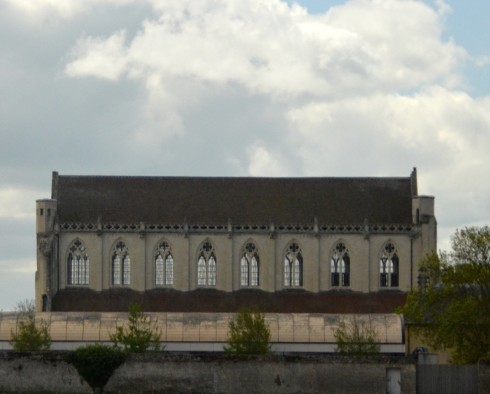
I knew that lots of weird shit went on at these places hundreds of years ago, but I had no idea of what happened here on June 7, 8 and 17th, 1944. As we exited the bus I noticed this ominous sign.
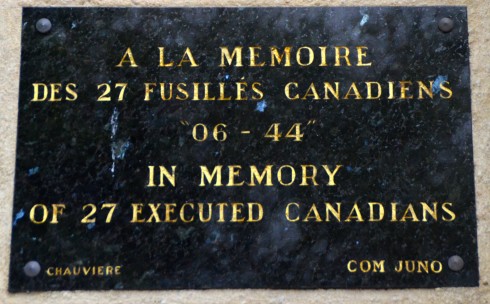
Phil then told us the story of Kurt Meyer, the SS officer who was responsible for the execution of captured Canadian POWs in several locations around Caen in the aftermath of the Allied landings on June 6th, 1944. Apparently this peaceful place designed for contemplation and prayer was his headquarters and the small garden was his preferred execution spot.
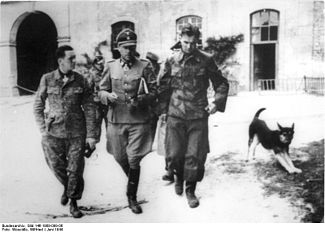
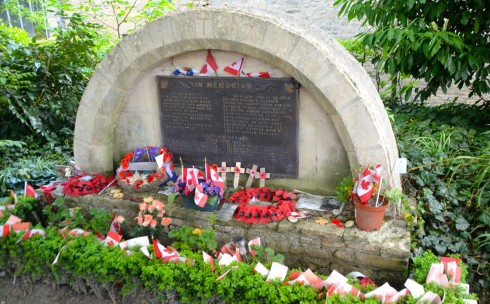
On June 7th five members of the Nova Scotia Highlanders (North Novas) and six members of the 27th Canadian Armoured Regiment (Sherbrooke Hussars) were taken out into the garden and one by one shot by members of the Hitler Youth under Meyer’s command. It was repeated the next day when seven more North Novas were similarly executed. On June 17th two more POWS were believed to have been shot.
Today the faces of the dead are posted on the very wall near where they were executed. It is incredibly poignant and moving, while at the same time creating a sickening feeling of anger at the people who did this.


The fact that majority of the murdered were Nova Scotians has not gone unnoticed as someone placed this Nova Scotia flag around a tree beside the memorial. It was hard not to get choked up just looking at it.
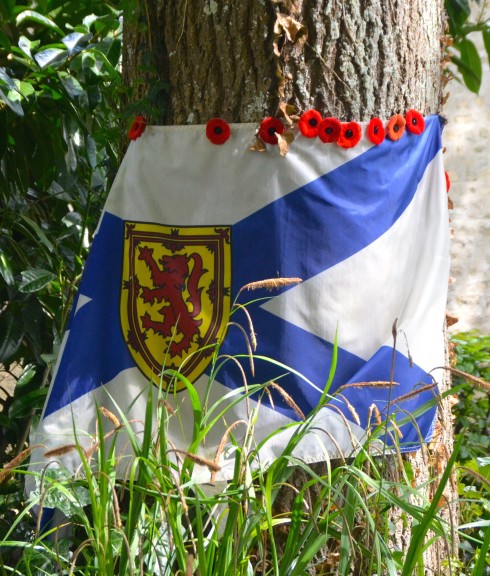
The link to the website above gives more detail on all the young men who died here. There are individual photos of a number of the North Novas posted on a garden wall with more information about them, but in French. Here are a few more details about some of them.
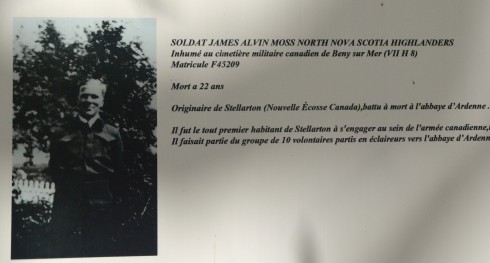
This is James Alvin Moss, son of Samuel and Elene Moss of Stellarton, Nova Scotia and he was 22 when he was murdered on June 7th, 1944. He is buried in Beny-sur-Mer Canadian War Cemetery which we visited a few days ago. I wish I had known about this massacre at the time as I would have looked up the graves in person.
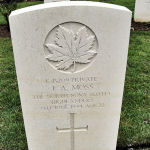
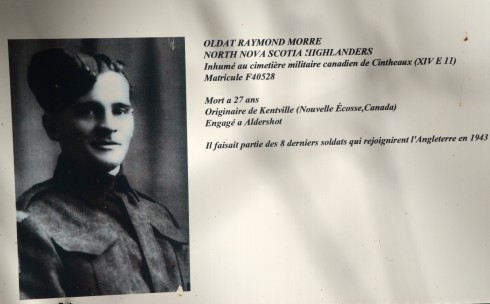
Raymond was the son of Charlie and Bertha Moore of Kentville, Nova Scotia and seems to have suffered a number of indignities in death other than just having his name spelled wrong. He was 29 when he was murdered, not 27 and there seems to be confusion about whether he was killed on the 7th or the 8th. The official site above lists him as being killed in the wave on June 8th, but his personal page and his tombstone say June 7th. With the number of war dead to be processed, there is no doubt that mistakes occur, but it must be hard on the family. Hopefully Raymond’s correct date of death will be established for certain in the future.
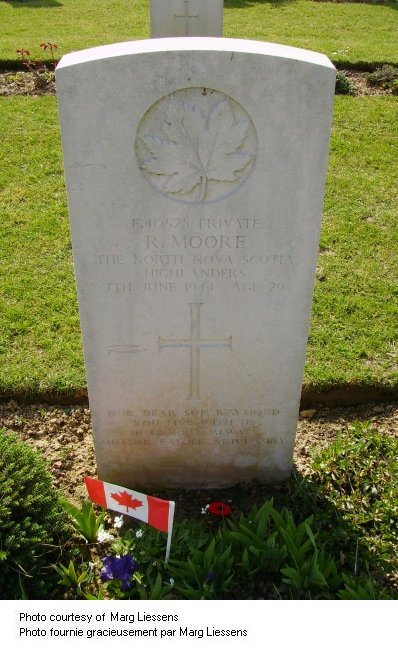
Last up is Thomas Edward Mont who also is the victim of a few mistakes including whether he perished on the 7th or 8th of June as per the comments on Raymond Moore. He was the son of Harry and Helen Mont and husband of Joan Louise Mont of Amherst, Nova Scotia. He is buried at Bretteville-sur-Laize Canadian War Cemetery, as is Raymond Moore.
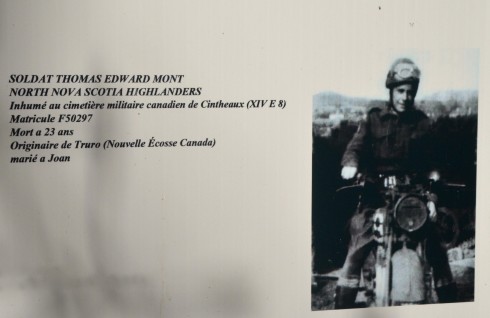
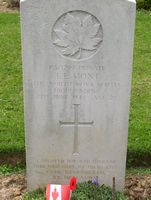
The reason I picked these three was that each was from what were then prosperous towns in rural Nova Scotia where most everybody would know each other. The very thought that in just two days they and fifteen others from small towns in Nova Scotia and rural Quebec could be so vilely mistreated is maddening. It’s one thing to face the chances of being taken prisoner and sent to a POW camp to serve out the war, it’s quite another to be summarily shot without benefit of due process or the rule of law.
Kurt Meyer and the Aftermath of Abbeye Ardenne
You might ask “What is he on about due process and the rule of law?” – well it has to do with what happened to Kurt Meyer after the war and why the aftermath of these murders is a Canadian outrage.
After a lengthy investigation by the Canadian War Crimes Commission (I didn’t even know we had one), Meyer was charged with five counts including the following two:
FOURTH CHARGE : COMMITTING A WAR CRIME
(Alternative to Third Charge)
in that he in the Province of Normandy and Republic of France on or about the 8th day of June, 1944, as Commander of 25 S.S. Panzer Grenadier Regiment, was responsible for the killing of prisoners of war in violation of the laws and usages of war, when troops under his command shot and killed seven Canadian prisoners of war at his Headquarters at L’Ancienne Abbaye Ardenne.
FIFTH CHARGE : COMMITTING A WAR CRIME
in that he in the Province of Normandy and Republic of France on or about the 7th day of June, 1944, as Commander of 25 S.S. Panzer Grenadier Regiment, was responsible for the killing of prisoners of war in violation of the laws and usages of war, when troops under his command killed eleven Canadian prisoners of war (other than those referred to in the Third and Fourth Charges) at his Headquarters at L’Ancienne Abbaye Ardenne.
These charges are specifically in relation to the massacres at Abbeye Ardenne on June 7th and 8th, 1944. I have underlined the most salient parts, namely that Meyer was responsible for the killings.
He was tried by a Canadian military court in Aurich Germany in December, 1945. Here is a summary of the proceedings. Meyer was found guilty of the two charges above and sentenced to be shot, an appropriate sentence given the gravity of the crimes and the numbers killed. Then the second outrage occurred (the killing of the POWs was the first outrage). This is a direct quote from the trial summary.
The Convening Authority, however, commuted the death sentence to one of life imprisonment, on the grounds that Meyer’s degree of responsibility did not warrant the extreme penalty.
This was a decision of Major-General Christopher Vokes about whom I would learn a lot more during the Liberation Tours Italian Campaign in 2017. He apparently reasoned that Meyer’s acquittal on a second charge of directly ordering the killings meant that he was not ultimately responsible.
So let me get this straight. We used to laugh off the old Nazi defence to war crimes that “I was only following orders” as an unacceptable attempt to dodge responsibility for one’s actions. However, if you were the one responsible for the killing of prisoners of war exactly as the charges he was convicted of read, then apparently you are less culpable and don’t deserve to suffer the ‘extreme penalty’ you meted out to others. If that was the case then Hitler, being far removed from any actual killing, would not be responsible for his orders.
So Meyer was sent from Germany to Dorchester Penitentiary in New Brunswick to serve his life sentence under the watchful eyes of the Canadian authorities who no doubt would look for any chance to make life in prison miserable for this bastard, but NO! Outrage number three – Meyer is freed to return to a British prison in Werl, Germany after serving less than five years. I am unable to find what imbeciles thought that this was a good idea and would not constitute a direct affront to every friend and relative of those killed and an indirect insult to every Canadian who served in Normandy.
By way of comparison as to how Canadians treat their own murderers, you cannot be released from a life sentence for pre-meditated murder, which this surely was, before serving a minimum of 25 years.
From there Meyer was released in 1954 to start a campaign justifying the actions of the SS in the war and 15,000 people attend his funeral in 1961. If there is a hell he must be in the inner circle.
Next we head for the scene of an even bigger Canadian tragedy, the small city of Dieppe and site of the worst military disaster in Canadian history. Please join us in trying to understand what went wrong with the Dieppe Raid.

